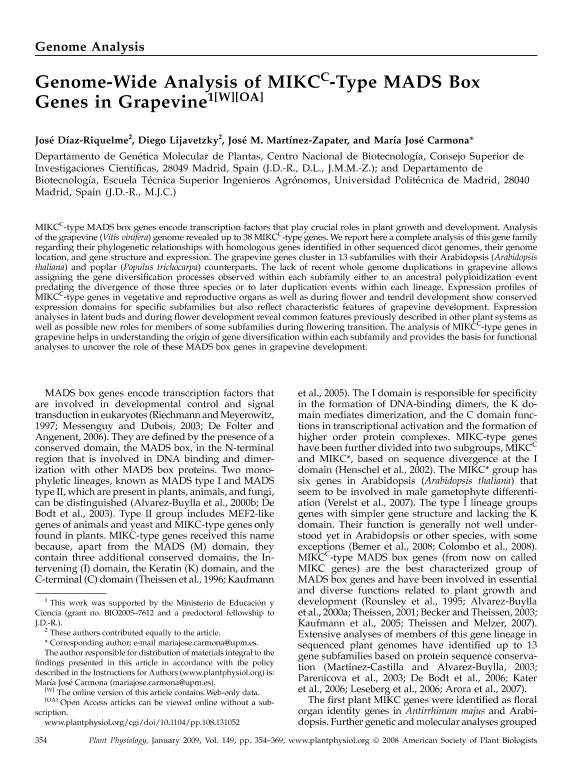Mostrar el registro sencillo del ítem
dc.contributor.author
Díaz Riquelme, José
dc.contributor.author
Lijavetzky, Diego Claudio

dc.contributor.author
Martínez Zapater, José M.

dc.contributor.author
Carmona, María José
dc.date.available
2020-06-08T16:00:54Z
dc.date.issued
2009-01
dc.identifier.citation
Díaz Riquelme, José; Lijavetzky, Diego Claudio; Martínez Zapater, José M.; Carmona, María José; Genome-Wide Analysis of MIKC C -Type MADS Box Genes in Grapevine; American Society of Plant Biologist; Plant Physiology; 149; 1; 1-2009; 354-369
dc.identifier.issn
0032-0889
dc.identifier.uri
http://hdl.handle.net/11336/106857
dc.description.abstract
MIKCC-type MADS box genes encode transcription factors that play crucial roles in plant growth and development. Analysis of the grapevine (Vitis vinifera) genome revealed up to 38MIKCC-type genes.We report here a complete analysis of this gene family regarding their phylogenetic relationships with homologous genes identified in other sequenced dicot genomes, their genome location, and gene structure and expression. The grapevine genes cluster in 13 subfamilies with their Arabidopsis (Arabidopsis thaliana) and poplar (Populus trichocarpa) counterparts. The lack of recent whole genome duplications in grapevine allows assigning the gene diversification processes observed within each subfamily either to an ancestral polyploidization event predating the divergence of those three species or to later duplication events within each lineage. Expression profiles of MIKCC-type genes in vegetative and reproductive organs as well as during flower and tendril development show conserved expression domains for specific subfamilies but also reflect characteristic features of grapevine development. Expression analyses in latent buds and during flower development reveal common features previously described in other plant systems as well as possible new roles for members of some subfamilies during flowering transition. The analysis of MIKCC-type genes in grapevine helps in understanding the origin of gene diversification within each subfamily and provides the basis for functional analyses to uncover the role of these MADS box genes in grapevine development.
dc.format
application/pdf
dc.language.iso
eng
dc.publisher
American Society of Plant Biologist

dc.rights
info:eu-repo/semantics/openAccess
dc.rights.uri
https://creativecommons.org/licenses/by-nc-sa/2.5/ar/
dc.subject
MADS Box
dc.subject
Grapevine
dc.subject
Genome analysis
dc.subject.classification
Ciencias de las Plantas, Botánica

dc.subject.classification
Ciencias Biológicas

dc.subject.classification
CIENCIAS NATURALES Y EXACTAS

dc.title
Genome-Wide Analysis of MIKC C -Type MADS Box Genes in Grapevine
dc.type
info:eu-repo/semantics/article
dc.type
info:ar-repo/semantics/artículo
dc.type
info:eu-repo/semantics/publishedVersion
dc.date.updated
2020-05-11T16:47:50Z
dc.journal.volume
149
dc.journal.number
1
dc.journal.pagination
354-369
dc.journal.pais
Estados Unidos

dc.journal.ciudad
Rockville
dc.description.fil
Fil: Díaz Riquelme, José. Consejo Superior de Investigaciones Cientificas. Center For Research In Agricultural Genomics; España
dc.description.fil
Fil: Lijavetzky, Diego Claudio. Consejo Nacional de Investigaciones Científicas y Técnicas. Centro Científico Tecnológico Conicet - Mendoza. Instituto de Biología Agrícola de Mendoza. Universidad Nacional de Cuyo. Facultad de Ciencias Agrarias. Instituto de Biología Agrícola de Mendoza; Argentina. Consejo Superior de Investigaciones Cientificas. Center For Research In Agricultural Genomics; España
dc.description.fil
Fil: Martínez Zapater, José M.. Consejo Superior de Investigaciones Cientificas. Center For Research In Agricultural Genomics; España
dc.description.fil
Fil: Carmona, María José. Universidad Politécnica de Madrid; España
dc.journal.title
Plant Physiology

dc.relation.alternativeid
info:eu-repo/semantics/altIdentifier/doi/https://doi.org/10.1104/pp.108.131052
dc.relation.alternativeid
info:eu-repo/semantics/altIdentifier/url/http://www.plantphysiol.org/content/149/1/354
Archivos asociados
